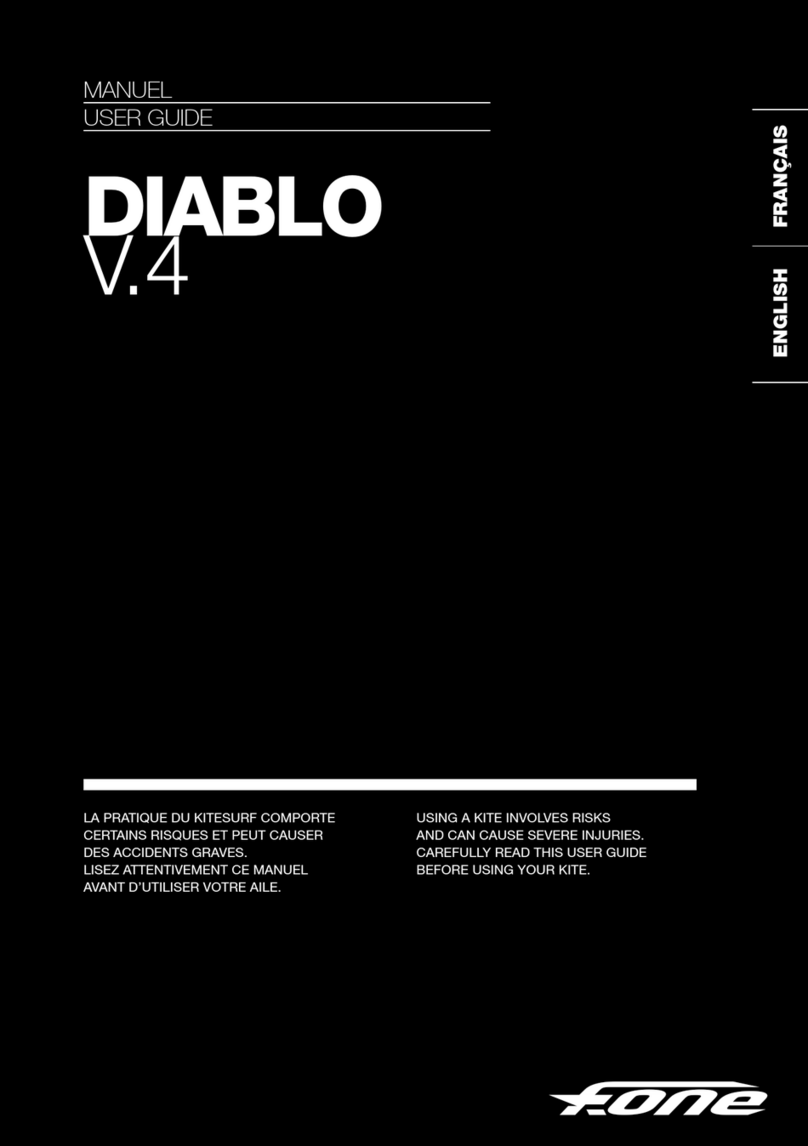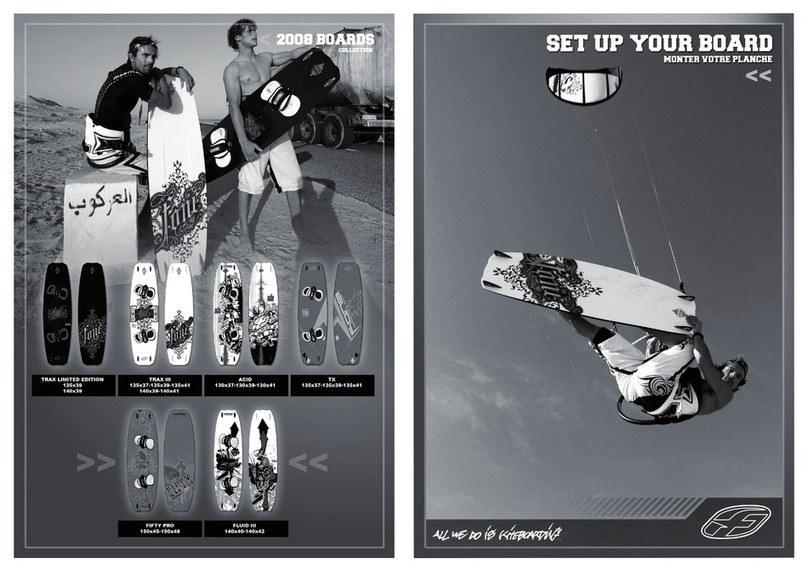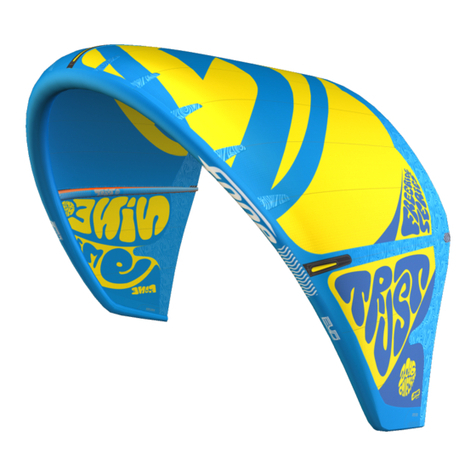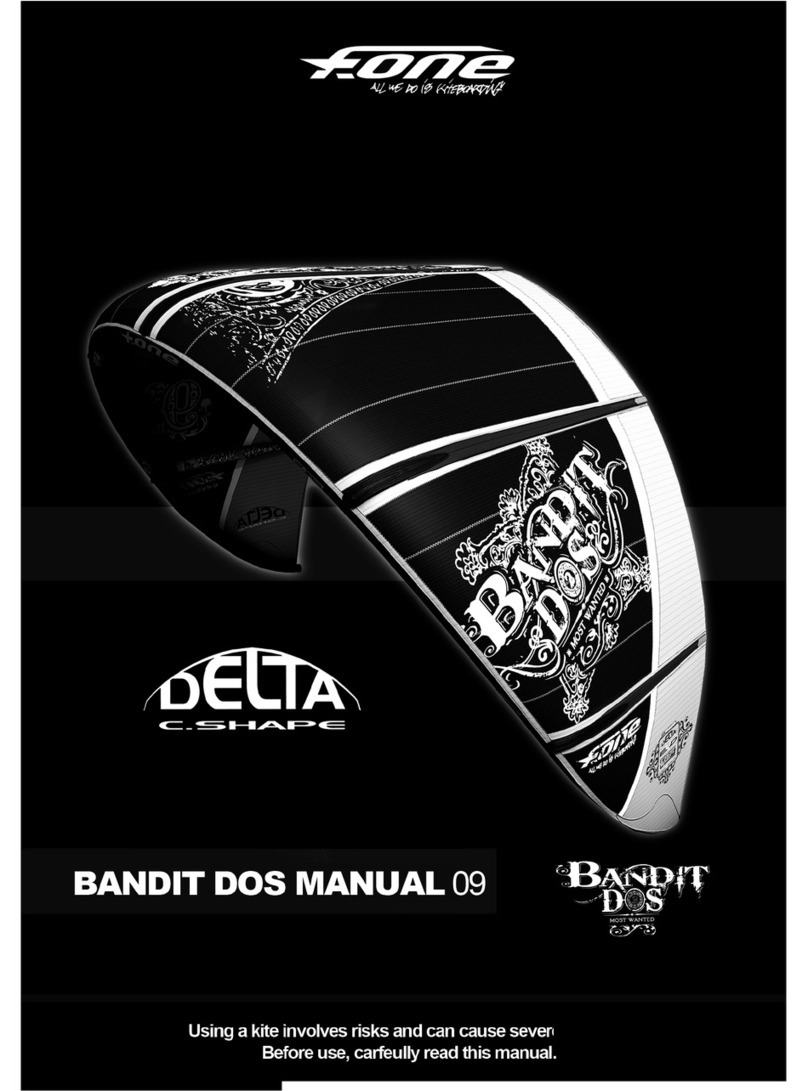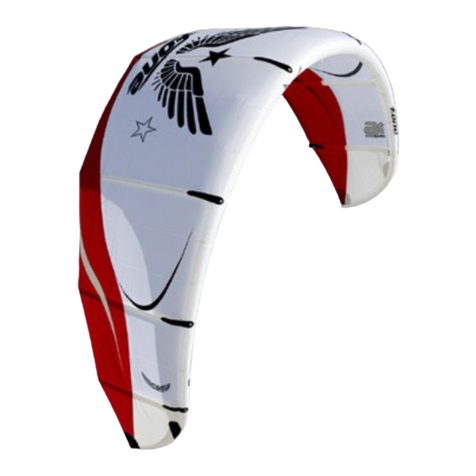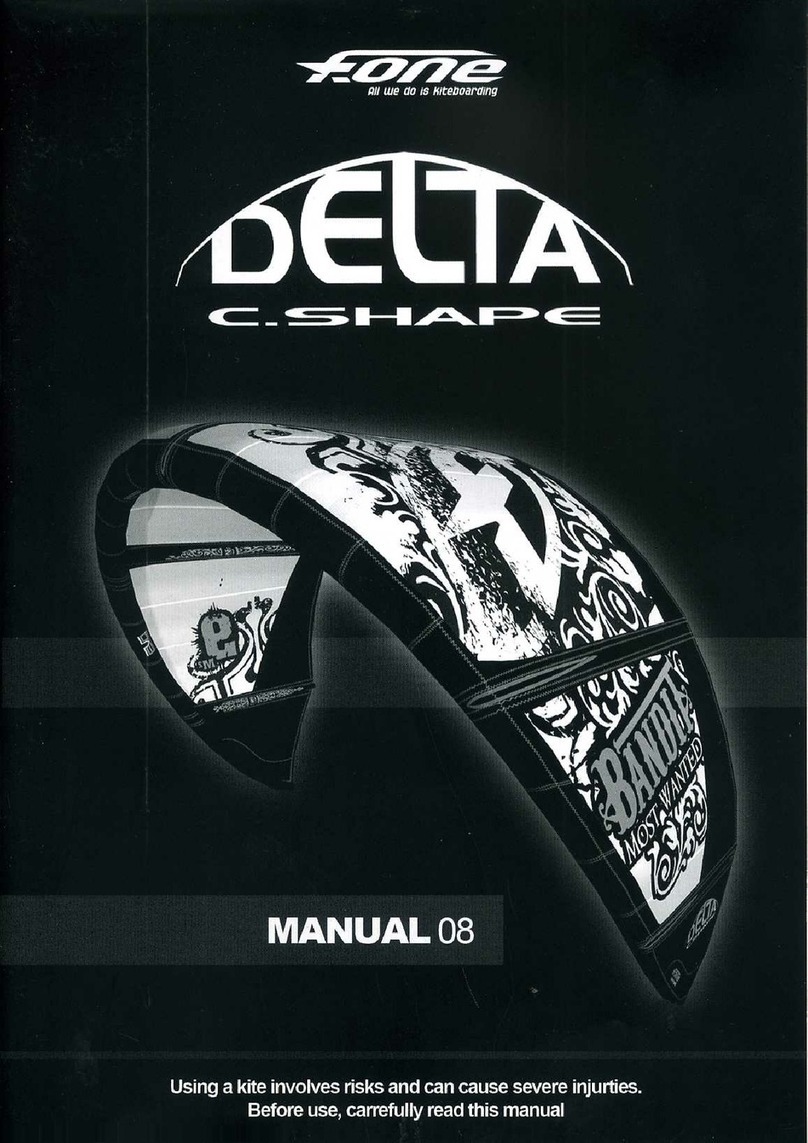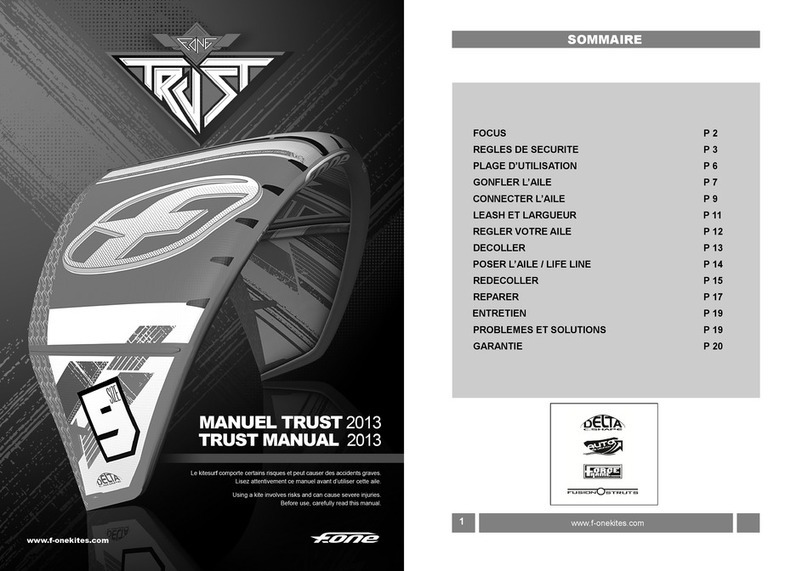Fone SWING User manual

SWING
FRANÇAISENGLISH
MANUEL
USER GUIDE
L’UTILISATION DE CETTE WING COMPORTE
CERTAINS RISQUES ET PEUT CAUSER
DES ACCIDENTS GRAVES. LISEZ ATTENTIVEMENT
CE MANUEL AVANT D’UTILISER VOTRE WING.
THE USE OF THIS WING INVOLVES RISKS
AND CAN CAUSE SEVERE INJURIES.
CAREFULLY READ THIS USER GUIDE
BEFORE USING YOUR WING.

_________________________________________________________________________________
FOCUS 02
PLAGE D’UTILISATION 03
RÈGLES DE SÉCURITÉ 03
GONFLER LA WING 05
POSER LA WING SUR LE SOL 06
PLIER LA WING 06
ATTACHER LE BOUT DE HARNAIS 07
REPARATIONS 08
ENTRETIEN 10
PIECES DETACHEES 10
GARANTIE 11
_________________________________________________________________________________
Voici une description de votre
matériel pour vous familiariser
avec les principaux termes.
FOCUS
SOMMAIRE
VOTRE AILE
01. Le bord d’attaque
02. La latte centrale
03. La poignée de bord d’attaque
04. Les oreilles
05. Points d’attache de bout de harnais
06. Le bord de fuite
07. La poignée avant
08. Les poignées arrière
VOS ACCESSOIRES
• Sac d’aile
• 1 kit de réparation comprenant :
1 poignée de valve + 1 kit de réparation d’aile
+ 1 connecteur de pompe
• 1 leash de poignet
PLAGES D’UTILISATION
LES PLAGES D’UTILISATION SONT
DONNÉES À TITRE INDICATIF POUR UN
RIDER DE 75 KG.
LA PLAGE D’UTILISATION VARIE EN
FONCTION DE CHAQUE PRATIQUANT.
ELLE DÉPEND DE 3 FACTEURS :
• De votre niveau : utilisez votre wing dans sa plage
d’utilisation basse si vous débutez ou si vous
l’utilisez pour la première fois.
• De votre gabarit : plus vous êtes lourd plus vous
utiliserez votre aile dans sa plage d’utilisation
haute.
• Du type de planche utilisé : SUP, SUP foil ou
Surf foil.
Vous devez choisir votre wing également en fonction
de votre compétence technique et de votre poids,
de la situation aérologique (qualité de l’écoulement
de l’air), de la situation météorologique (orientation
et force du vent, évolution), du plan d’eau utilisé,
de la sécurité disponible sur le plan d’eau, du type
de navigation envisagé. Lorsque vous arrivez sur le
spot, mesurez le vent.
Bft Km/h nœuds Description
___________________________________________________________________________________________________________________
00 <1 <1 Calme, la fumée s’élève verticalement.
01 1-5 1-3 Soupçon de vent.
02 6-11 4-6 Brise légère.
03 12-19 7-10 Les drapeaux ottent.
04 20-28 11-16 Brise modérée et premiers « moutons »
05 29-38 17-21 Les arbres bougent.
06 39-49 22-27 Le sable vole sur la plage.
07 50-61 28-33 Avis de grand frais.
08 62-74 34-40 Marche difcile face au vent.
09 75-88 41-47 Fort coup de vent.
10+ >89 >48 Restez chez vous !
___________________________________________________________________________________________________________________
Ce tableau n’est donné qu’à titre indicatif. Vous devez vous méer des vents irréguliers.
Attention, car à force égale, certains vents sont plus portants que d’autres.
Renseignez-vous auprès des locaux.
RÈGLES DE SÉCURITÉ
AVANT D’UTILISER VOTRE AILE, LISEZ ATTENTIVEMENT CE MANUEL ET CONSERVEZ
LE POUR UNE CONSULTATION ULTÉRIEURE.
VOICI QUELQUES RÈGLES DE SÉCURITÉ À CONNAÎTRE ET À RESPECTER :
L’équipement (casque, gilet…) contribue à votre sécurité mais la meilleure sécurité
reste la prudence et l’attention.
23
FRANÇAISENGLISH
1
2
3
4
8
6
7
5 5
SIZE (m2)
WIND RANGE (knts)
TAILLE (m2)
PLAGE DE VENT (nds)
SWING
2.2 2.8 3.5 4.2 5.0 6.0
30>50+ 25 > 42 20 > 35 15 > 30 12 < 25 08 < 20

LE CASQUE
Le casque est indispensable en cas d’utilisation
d’un leash de planche pour vous protéger du
retour de celle-ci lors des chutes. Il vous sauvera
également dans d’autres conditions inattendues.
LA COMBINAISON
Choisissez une combinaison intégrale
(eau<19°) ou un shorty (eau>19°) selon la
température de l’eau. Sachez que lorsque vous
avez froid vous consommez plus d’énergie.
LE GILET
Le gilet peut faciliter le waterstart. C’est aussi un
véritable compagnon de galère lorsqu’il faut rentrer
à la nage.
LE LEASH DE POIGNET
Attachez le leash de poignet sur le connecteur de
pompe an de ne pas perdre votre wing.
LE LEASH DE PLANCHE
Nous recommandons aux utilisateurs de la SWING
de porter un leash de planche à la cheville
BOUT DE HARNAIS (OPTIONNEL)
Vous pouvez attacher un bout de harnais
sur les points d’attache de la latte centrale.
LA PLANCHE
Choisissez une planche avec sufsamment de
volume pour otter debout.
La Swing n’est pas un engin volant (parapente)
ou ottant (embarcation) et ne peut être utilisée
comme tel. Ne partez jamais naviguer seul. Il est
conseillé de pratiquer en présence d’une personne
qui pourra, en cas d’incident, prévenir des secours.
RÈGLE N°1 - VOTRE SÉCURITÉ
RÈGLE N°2 - ÉQUIPEZ-VOUS
RÉGLEMENTATION EN VIGUEUR
Selon l’article 240-2.11 paru au journal ofciel du 12 mai 2019, les planches aérotractées comportent un
identiant de la personne, physique ou morale, qui en est le propriétaire et permettant de la contacter.
Cet identiant, en caractères d’un centimètre minimum de hauteur, doit être inscrit sur la voile ou sur un
support qui en est solidaire. Il doit être constitué soit par le nom soit par les coordonnées téléphoniques
ou électroniques du propriétaire ou par plusieurs de ces identiants.
A partir de 300 m d’un abri, ils doivent porter en permanence le matériel d’armement et de sécurité
basique ainsi constitué :
- une aide à la ottabilité d’une capacité minimale de 50 N ou une combinaison humide en néoprène
ou sèche assurant au minimum une protection du torse et de l’abdomen, une ottabilité positive et une
protection thermique ;
- un moyen de repérage lumineux individuel. Il doit être étanche et avoir une autonomie d’au moins 6
heures. Il peut être de type lampe ash, lampe torche ou cyalume.
CHOISISSEZ VOTRE SPOT EN FONCTION
DE VOTRE NIVEAU
Le choix du spot est primordial pour un apprentissage
en sécurité. Si vous débutez ou si vous ne maîtrisez
pas encore totalement votre wing, le bon spot est un
spot sans trop de monde sur l’eau.
Le choix du plan d’eau et de la force du vent varient
aussi, les wingsurfers expérimentés recherchent de
la houle au large et du vent plus fort alors qu’il est
préférable pour les débutants de choisir un plan
d’eau relativement plat et du vent léger.
L’ORIENTATION DU VENT
Ne naviguez jamais par vent off-shore si vous n’avez
pas de bateau d’assistance. Par vent offshore il est
plus difcile de rentrer à la nage, le vent et le courant
vous poussant vers le large. Vous n’êtes jamais à
l’abri du vent qui tombe.
Le vent on-shore rendra votre apprentissage plus
difcile : vous ne pouvez pas faire de longs bords
si vous ne capez pas et vous arriverez très vite sur
le sable.
Il faut donc naviguer par vent side ou side-on, vous
pourrez ainsi à loisir descendre le vent tout en étant
sûr de pouvoir rentrer à terre facilement au moindre
problème.
RÈGLE N°3 - CHOISISSEZ VOTRE LIEU DE PRATIQUE
RÈGLES DE SÉCURITÉ
Informez-vous sur la météo avant d’aller
naviguer (téléphone, web, capitainerie). Quelle
force de vent est annoncée et quelle direction ?
Vous devez savoir comment la force et la direction
du vent vont évoluer au cours de la journée.
Vous ne devez pas naviguer par temps orageux,
la Swing attire la foudre. Renseignez-vous
également sur les horaires des marées et les
zones de courants forts.
LA ZONE SOUS LE VENT
Ayez toujours à l’esprit que vous risquez de
descendre le vent, que vous débutiez ou
pas. Vous n’êtes pas à l’abri de perdre votre
planche donc la plage sous votre vent doit être
accessible. Prévoyez de devoir rentrer à pied
le long de la plage (vériez qu’il n’y ait pas de
falaise, rocher, barrière, bâtiment, digue sous le
vent qui vous gêneraient).
Si vous débutez ou si vous ne contrôlez
pas encore bien votre wing, faites attention
également à bien vous placer sur le spot : si il y
a assez d’espace, mieux vaut vous placer sous
le vent des autres pratiquants pour éviter d’avoir
à les croiser.
RESPECTEZ LES PRIORITÉS SUR L’EAU
Lorsque deux wingsurfers se croisent, le wing-
surfer qui navigue avec le vent venant de tribord
(main droite devant) par rapport à sa route est
prioritaire face à un wingsurfer dont le vent vient
de bâbord (main gauche devant).
Le wingsurfer tribord doit garder tant que pos-
sible sa route et le wingsurfer bâbord doit tout
faire pour ne pas entraver cette route.
Avant tout saut ou tout changement de direc-
tion, vériez l’espace disponible et que vous
n’allez gêner personne.
Dans tous les cas, vous devez appliquer le
règlement international pour prévenir les abor-
dages en mer (RIPAM).
RESPECTEZ LE PUBLIC
Ne conez pas votre matériel à une personne
qui n’a jamais pratiqué.
RÈGLE N°4 - VÉRIFIEZ LES CONDITIONS MÉTÉOROLOGIQUES
RÈGLE N°3 - CHOISISSEZ VOTRE LIEU DE PRATIQUE
RÈGLE N°5 - RESPECTEZ ET AIDEZ LES AUTRES
GONFLER LA WING
45
FRANÇAISENGLISH
—1—
Déterminez la direction du vent.
—2—
Dépliez votre wing en vous plaçant dos au vent
et posez-la sur le sable, lattes tournées vers le
ciel.
—3—
Attachez le leash de votre pompe au connecteur
qui se trouve au centre du bord d’attaque à
l’aide du crochet.
—4—
Avant de goner, vérier que la valve est en
position fermée. Connectez l’embout de pompe
adapté sur la valve en le verrouillant avec un
quart de tour. Gonez l’aile jusqu’à la pression
conseillée. Déconnectez la pompe et refermez
le bouchon de la valve (primordial).
—5—
Attrapez votre wing par la poignée située sur le
bord d’attaque et déplacez-vous avez la wing
en drapeau, le bord d’attaque face au vent.
PRESSION CONSEILLÉE POUR LE GONFLAGE
__________________________________________________________________________________________________________________
2.2 m210 psi
2.8 m2 10 psi
3.5 m208 psi
4.2 m207 psi
5.0 m2 06 psi
6.0 m2 06 psi
__________________________________________________________________________________________________________________

PLIER L’AILE
ATTACHER LE BOUT DE HARNAIS
POSER LA WING SUR LE SOL
VOUS POUVEZ POSER VOTRE WING SUR LA PLAGE DE DEUX MANIÈRES DIFFÉRENTES:
67
FRANÇAISENGLISH
Pour ouvrir ou fermer la valve, commencez par ouvrir le
bouchon en le tournant d’un quart de tour.
La valve se manipule par une simple pression sur
le bouton poussoir central rouge. Si le bouton est
enfoncé, la valve est ouverte. Si le bouton est sorti, la
valve est fermée.
Veillez à toujours refermer le bouchon le verrouillant par
un quart de de tour.
POUR UN BON FONCTIONNEMENT
DANS LE TEMPS
• Evitez de laisser entrer du sable dans la valve.
• Veillez en particulier à ce que l’embout de gonage ne
soit pas rempli de sable au moment de la connexion
avec la valve.
• Lorsque l’aile n’est pas utilisée veillez à refermer le
bouchon de protection.
• Assez régulièrement, démontez la valve et rincez la
à l’eau claire.
—1—
Dégonez l’aile dos au vent —2—
Roulez les deux extrémités et pliez en 2
—1—
Soit attachée à quelque choseavec le leash de
poignet (un arbre, une barrière, un planche etc.)
—2—
Soit sur le dos avec du sable dans le prol
—1—
Prenez votre bout de harnais du côté où se
trouvent les nœuds de réglage, et passez-le
dans la sangle d’accroche située entre les 2
poignées de main arrière.
—2—
Faites une tête d’alouette.
—3—
Prenez l’autre côté du bout de harnais et
passez-le dans la tête d’alouette.
—4—
Faites glisser tout le bout de harnais dans
la tête d’alouette et choisissez un nœud de
réglage adapté à vos besoin. Serrez la tête
d’alouette contre le nœud choisi.
—1—
Prenez l’autre côté du boutde harnais et faites
une tête d’alouette.
—2—
Serrez la tête d’alouette autour du nœud prévu
à cet effet, qui se trouve derrière la poignée de
main avant.

RÉPARATIONS
89
FRANÇAISENGLISH
AVANT TOUTE RÉPARATION, METTEZ-VOUS À L’ABRI DU SABLE, DE L’EAU ET DU VENT, SUR
UNE SURFACE PROPRE. VOUS AVEZ BESOIN D’UNE LIGNE DE VOL, DU KIT DE RÉPARATION
FOURNI ET D’UN MARQUEUR.
RÉPARER LE BOUDIN DU BORD D’ATTAQUE
Si vous avez une fuite dans le bord d’attaque, il vous faudra le sortir avec ses tuyaux de connexion.
SI LA FUITE OU LES DÉGÂTS SONT TROP IMPORTANTS, CONTACTEZ UN RÉPARATEUR
—1—
Vous devez déconnecter le tuyau coté lattes.
—2—
Démontez la valve REACTOR
(voir instructions ci après)
—3—
Attachez une ligne à chaque extrémité
du bord d’attaque et le sortir.
—4—
Identiez la fuite
—5—
Poncez puis collez la rustine à l’aide du kit
de réparation livré avec l’aile.
—6—
Replacez le bord d’attaque en se servant des
lignes.
CHANGER OU DÉMONTER
LA VALVE REACTOR
—1—
Se munir du « repair kit » et ouvrir le bouchon
extérieur.
—2—
Dévissez la valve de son embase à l’aide de la
poignée prévue à cet effet.
—3—
Retirez la valve une fois complètement
dévissée.
Pour changer de valve, installer la valve de
rechange en la vissant à la place dans l’embase
à l’aide de la poignée
Pour changer le boudin de bord d’attaque,
retirer l’embase de la valve. Pour cela, passez la
main par l’ouverture ainsi créée et désolidarisez
l’embase de l’intérieur du bord d’attaque en
retirant le velcro.
RÉPARER LA LATTE
Votre boudin à réparer doit être complètement
dégoné. Déconnectez votre latte du côté du
bord d’attaque. Attachez le bout de la ligne
autour de la valve. Enfoncez délicatement la
valve à l’intérieur de la latte. Décrochez le velcro
à l’extrémité de la latte et sortez la chambre à air
par cette extrémité en tirant dessus. Assurez-
vous que la ligne passe bien dans la latte. Elle
vous permettra de remettre la chambre à air en
place après l’avoir réparée. Défaites la ligne de
la valve et laissez-la dépasser à l’extérieur de
la latte.
Gonez votre latte et serrez le tuyau. Si vous
ne trouvez pas le trou au son ou au toucher,
plongez la latte dans une bassine d’eau. Vous
pourrez ainsi localiser la fuite grâce aux bulles
d’air. Si le trou n’apparaît toujours pas, pressez
sur la latte pour augmenter la pression. Séchez
la partie trouée et entourez le trou au marqueur.
Séchez le reste de la chambre à air (à la
serviette, pas de sèche-cheveux) puis
dégonez-là. Recouvrez le trou d’une rustine,
frottez pour éviter les bulles d’air. Pressez la
rustine une minute.
Renouez la ligne autour de la valve de la
chambre à air. Rentrez la chambre à air dans
l’extrémité de la latte puis tirez sur votre ligne
de l’autre côté jusqu’à pouvoir attraper la valve.
Repositionnez-la correctement, détachez-la
ligne. Repositionnez le velcro à l’extrémité de
la latte.
Gonez partiellement la latte pour voir si la
chambre à air n’est pas vrillée et si elle est bien
positionnée dans les quatre coins de la latte.
RÉPARER LE SPI
Pour réparer le spi de votre aile, utilisez du spi
autocollant. Vous pouvez en trouver dans un
magasin de kitesurf ou dans les voileries.
Avant d’effectuer votre réparation, votre aile
doit être rincée et sèche. Mettez-vous dans
un lieu à l’abri sur une surface dure, plane et
propre : table ou sol.
Coupez deux morceaux de spi autocollant
légèrement plus grands que la taille de votre
déchirure. Arrondissez les bords de vos
morceaux de spi pour une meilleure tenue.
Collez l’un des morceaux de spi d’un côté de la
déchirure en frottant délicatement pour le faire
adhérer. Collez l’autre morceau de l’autre côté.
Si la déchirure est trop importante (supérieure
à 10 cm) prenez contact avec votre revendeur
qui vous donnera l’adresse d’un atelier de
réparation.
Table of contents
Languages:
Other Fone Aircraft manuals
